Cliffs
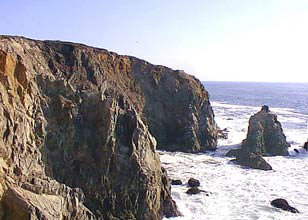 Along several stretches of the Reserve’s boundary with the Pacific Ocean the cliffs are steep, crumbly and nearly impossible to climb up or down safely. A fall from any of these ledges can be disastrous. Always stay a safe distance away from bluff edges and never attempt to climb the cliffsides.
Along several stretches of the Reserve’s boundary with the Pacific Ocean the cliffs are steep, crumbly and nearly impossible to climb up or down safely. A fall from any of these ledges can be disastrous. Always stay a safe distance away from bluff edges and never attempt to climb the cliffsides.
Sleeper Waves
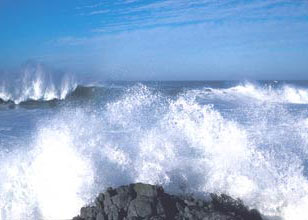 This term refers to waves that are disproportionately larger than all other waves in a series. These dangerously large waves occur when different wave trains coincide, with their crests peaking at the same time. They are unpredictable and will surprise you, washing you from rocks or the beach into deep, cold water. Every year people lose their lives to such waves along the northern California coast.
This term refers to waves that are disproportionately larger than all other waves in a series. These dangerously large waves occur when different wave trains coincide, with their crests peaking at the same time. They are unpredictable and will surprise you, washing you from rocks or the beach into deep, cold water. Every year people lose their lives to such waves along the northern California coast.
The best way to avoid being taken by surprise is to stay alert and never turn your back on the ocean. If a large wave hits you, drop everything and hang on tight. Be certain another large wave is not about to land before you loosen your grip. Some areas of the rocky intertidal zone are particularly dangerous because of steep, exposed rocks backed by cliffs. Researchers should consult with the Reserve Manager before entering any intertidal areas.
White Sharks
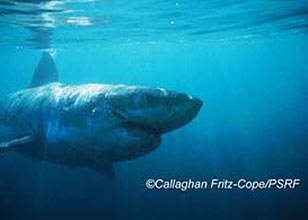 These large sharks are present in the waters adjacent to the Reserve. The harbor seal haul-out in front of the laboratory and the sea lion haul-out at the southern tip of Bodega Head probably attract these top predators. Fortunately, there have not been any attacks on research divers here, but the possibility exists. If you are planning to conduct subtidal research in the Bodega Marine Life Refuge, always check with the Diving Safety Officer prior to your scheduled dive date(s). Once in the water it is best to minimize time at the surface, and always maintain close contact with your dive buddy.
These large sharks are present in the waters adjacent to the Reserve. The harbor seal haul-out in front of the laboratory and the sea lion haul-out at the southern tip of Bodega Head probably attract these top predators. Fortunately, there have not been any attacks on research divers here, but the possibility exists. If you are planning to conduct subtidal research in the Bodega Marine Life Refuge, always check with the Diving Safety Officer prior to your scheduled dive date(s). Once in the water it is best to minimize time at the surface, and always maintain close contact with your dive buddy.
For more information on sharks of coastal California visit the Pelagic Shark Research Foundation. For more information on shark attacks visit the International Shark Attack File.
Poison Oak
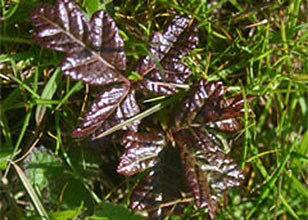 This highly variable plant can be irritating to the skin and is found in some locations on the Reserve. At our site it grows low to the ground, in the dunes nearest the Lab road and around rock outcroppings on grassland hillsides. The leaves are shiny green in spring, turn red in late summer, and drop from the stems during autumn. The plant’s oils, which cause the irritation, are present year-round. If poison oak is touched or brushed against, the affected area should be washed with soap and water, or cleansed with Tecnu, as soon as possible. Avoid touching your face if your hands have come in contact with the plant. Touching field clothing or equipment that has brushed against the plant can also spread the irritant.
This highly variable plant can be irritating to the skin and is found in some locations on the Reserve. At our site it grows low to the ground, in the dunes nearest the Lab road and around rock outcroppings on grassland hillsides. The leaves are shiny green in spring, turn red in late summer, and drop from the stems during autumn. The plant’s oils, which cause the irritation, are present year-round. If poison oak is touched or brushed against, the affected area should be washed with soap and water, or cleansed with Tecnu, as soon as possible. Avoid touching your face if your hands have come in contact with the plant. Touching field clothing or equipment that has brushed against the plant can also spread the irritant.
Ticks and Lyme Disease
 Lyme disease is caused by a spirochete, Borrelia burgdorferi, which is transmitted to humans through the bite of a western black-legged tick (Ixodes pacificus). Symptoms of the disease are often flu-like, including fatigue, headaches, muscle aches, fever and chills. In many, but not all, cases, a circular, bull’s-eye rash occurs within the days of the tick bite. Treatment with antibiotics during early stages of the disease is usually effective, but Lyme disease has very serious effects if left untreated.
Lyme disease is caused by a spirochete, Borrelia burgdorferi, which is transmitted to humans through the bite of a western black-legged tick (Ixodes pacificus). Symptoms of the disease are often flu-like, including fatigue, headaches, muscle aches, fever and chills. In many, but not all, cases, a circular, bull’s-eye rash occurs within the days of the tick bite. Treatment with antibiotics during early stages of the disease is usually effective, but Lyme disease has very serious effects if left untreated.
Though the incidence of the spirochete in western black-legged ticks on the Reserve is low, the ticks are common here during winter, spring and early summer. Precautions against tick bite include wearing light colored field clothes, so ticks are more easily seen; tucking pant legs into socks or boots; using insect repellents that contain DEET (n,n-diethyl-m-toluamide); and being alert to tick presence on your clothes or body after time spent in the field.
If you are bitten by a tick, early removal is important to minimize the risk of transmission of the spirochete from the tick to your blood. Using a pair of tweezers, grab the tick as close to the skin as possible. Pull the tick straight out, slowly and steadily, giving the tick time to release its grip. It is wise to save the tick for testing on the chance that symptoms may occur following the bite. If you suspect the possibility of Lyme disease, consult your physician.
More information about ticks and Lyme disease in California
Hantavirus
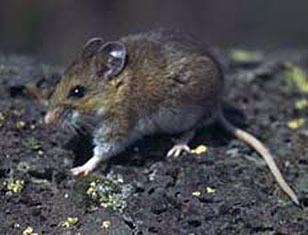 Hantavirus is a potentially deadly disease transmitted via rodent feces, urine and saliva. Although we believe the risk of hantavirus is extremely low on the Reserve, we mention it here because of the seriousness of the disease (more than 40% of those infected with the virus elsewhere have died). We are not aware of a single documented case in humans in all of Sonoma County, but the deer mouse (Peromyscus maniculatus), the principal vector of the virus, is common on the Reserve.
Hantavirus is a potentially deadly disease transmitted via rodent feces, urine and saliva. Although we believe the risk of hantavirus is extremely low on the Reserve, we mention it here because of the seriousness of the disease (more than 40% of those infected with the virus elsewhere have died). We are not aware of a single documented case in humans in all of Sonoma County, but the deer mouse (Peromyscus maniculatus), the principal vector of the virus, is common on the Reserve.
Symptoms include fever, headache, muscle aches, vomiting, and abdominal pain, and may worsen over a brief period of hours to days. Respiratory failure can follow rapidly.
There is no specific treatment for hantavirus infection other than early diagnosis and proper medical care.
Transmission of the virus can occur through inhalation of airborne particles of urine, droppings, or saliva from an infected mouse or through the handling of infected rodents, nests, or droppings. To avoid the chance of exposure, leave rodents alone and take proper precautions when working in closed areas inhabited by deer mice. Link to information about Hantavirus in California ![]()
This text is modified from a brochure provided by the State of California Department of Health Services.
Mountain Lions
 Cougar sightings on the Reserve are rare, but cougars are probably regular visitors to Bodega Head and Dunes, drawn by the large deer population. There have been no reported cases of cougar attacks in Sonoma County, but it is prudent to be aware of the possibility and to remain alert while working on the Reserve.
Cougar sightings on the Reserve are rare, but cougars are probably regular visitors to Bodega Head and Dunes, drawn by the large deer population. There have been no reported cases of cougar attacks in Sonoma County, but it is prudent to be aware of the possibility and to remain alert while working on the Reserve.
If you see a cougar, consider yourself one of the lucky few, but take the following precautions:
- Stop and remain calm.
- Do not approach the animal for a better look.
- Do not turn and run away.
- Make yourself appear larger using your coat, field equipment, etc.
- If the animal approaches you, throw sticks or other items and speak loudly and firmly to it. Let it know you are not prey and that you might be dangerous.
- If it attacks, fight back and try to remain standing.
More information on mountain lions in California
Skunks
 Skunks are an important part of the ecosystem and have a hearty appetite for invertebrates, small vertebrates and plants. Skunks will usually come out in the evening and early morning hours, resting at night and sleeping during the day. However, in the winter and early spring, when they have young, they will forage for food at almost any time of day and it is not uncommon to see a skunk on the Reserve in broad daylight. Skunks are poor runners, which when coupled with myopic vision, may explain why so many are killed by cars.
Skunks are an important part of the ecosystem and have a hearty appetite for invertebrates, small vertebrates and plants. Skunks will usually come out in the evening and early morning hours, resting at night and sleeping during the day. However, in the winter and early spring, when they have young, they will forage for food at almost any time of day and it is not uncommon to see a skunk on the Reserve in broad daylight. Skunks are poor runners, which when coupled with myopic vision, may explain why so many are killed by cars.
By taking some precautions a person can avoid being sprayed during human/skunk encounters. Skunks are nearsighted and often confuse quick and loud movements with those of a predator. Therefore if you move slowly and talk softly during skunk encounters you can usually avoid being sprayed. If avoidance is not possible, and you and a skunk come face to face, the skunk will typically warn you before spraying. Skunks run directly toward a threat, stop (sometimes within inches), then stomp, hiss and assume a tail-high pose. If you encounter this threatening posture, slowly move away. If you are sprayed, a mixture containing hydrogen peroxide (32 oz), baking soda (2 oz) and liquid soap (1 oz) has been found to be the most effective smell removal agent.
